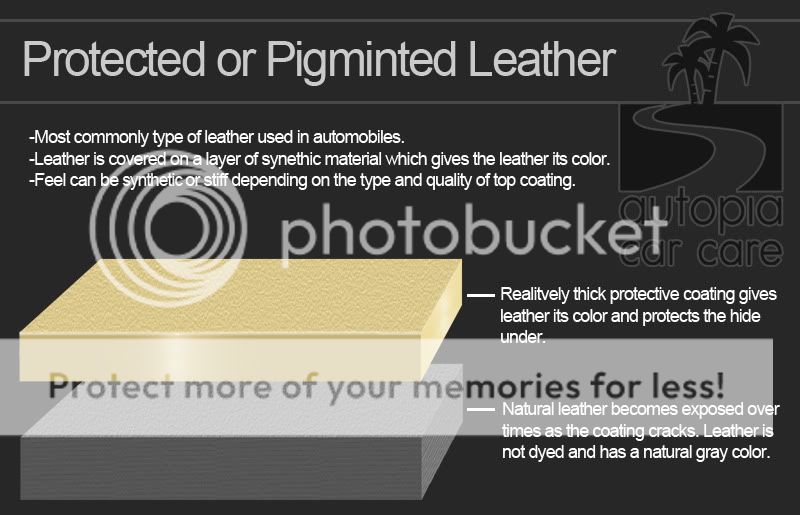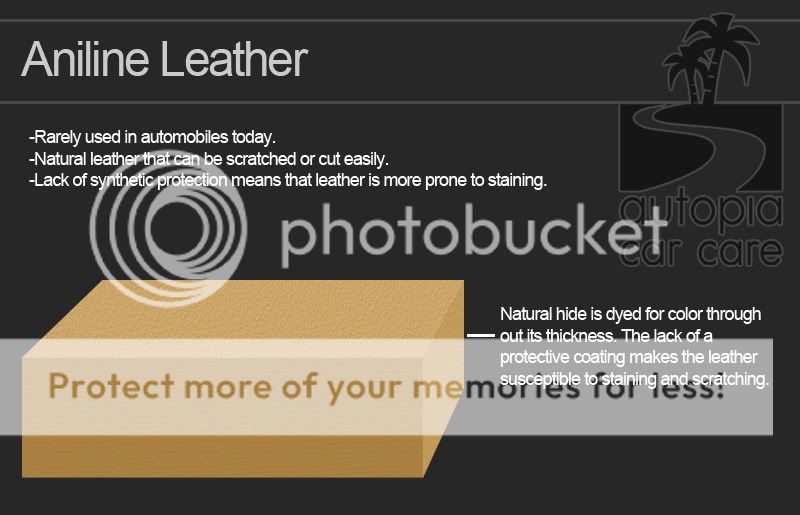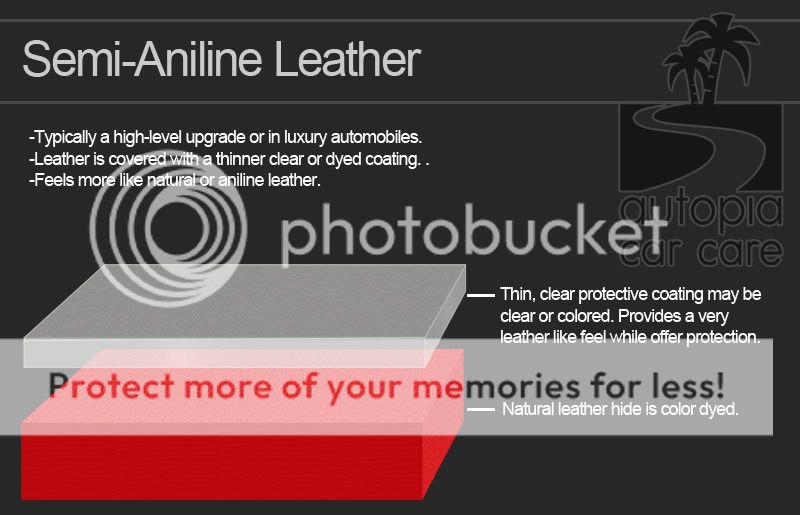Leather hides (typically from cattle) used for upholstery are currently chromium salt tanned (to preserve the hide), fat liquored (to provide softness, strength and flexibility (fats and oils are added)), and then dyed (to give them color). At this point, all leathers are more or less the same. The leather hides are often too thick for immediate use in automotive applications and, hence, the leather is split…the top is called ‘top-grain’ and the bottom is called ‘split’. From the point of view of detailing, however, whether it is top-grain or split is not really that important…what’s more important is how the leather is ‘finished’. For automotive applications the finish is perhaps the most important aspect of the leather manufacturing process as the finish affects many of the leather’s properties and the finish determines how should one care for it.
TYPES OF LEATHER
Automotive leather can come in various styles which include the following: Aniline, Semi-Aniline, and Pigmented (Coated/Protected) leather. Aniline leather is almost never found in automobiles today, although some older and specialty vehicles use this. Pigmented leather is the most commonly used and the quality can vary wildly. Finally, semi-aniline, most commonly found in higher end vehicles, is somewhere in the middle.
- Pigmented Leather
 This is the leather that can be coated with a synthetic material that is why it is also referred to as coated or protected leather. It is the most versatile due to the synthetic coat that goes over the hide. The hide retains its natural dark tan (usually dark gray) since it is the protective layer that gives the upholstery the desired pigmentation.
This is the leather that can be coated with a synthetic material that is why it is also referred to as coated or protected leather. It is the most versatile due to the synthetic coat that goes over the hide. The hide retains its natural dark tan (usually dark gray) since it is the protective layer that gives the upholstery the desired pigmentation.
The manufacturer has the option of using a thick pigmentation layer to protect the hide better or go for high-end thin coatings that not only protect the processed hide well but also retain that natural feel and look. Thickly coated variants are cheaper to produce since the manufacturer can use low-quality hides and count on the thick protective coating to mask the flaws. These less expensive or thicker coatings will feel more vinyl like or stiff. Thick coatings are usually used in cheaper vehicles because the coating hides the natural flaws in the leather, making it less expensive to finish.
Most car interiors use pigmented finishes. This gives one the freedom to do a perfect balance between cost and looks and end up something that is as close to that perfect upholstery as one can afford.
Care
Caring for pigmented leather is truly about keeping the leather clean. Dirt and particulate will scratch and wear the leather leading to shiny appearance and exposure of the leather hide underneath. Acidic body oils can wear or stain the vacuum frequently and use a gentle, water based cleaner to remove embedded dirt and oil. Use a protectant or conditioner that features protectants (to reduce abrasion and increase sun fade resistance). Over time the leather coating will crack microscopically or stretch in the seams and folds. Conditioners can penetrate the coating through these cracks and openings, keeping the leather underneath soft and supple.
- Aniline Leather

Aniline gives you a hide in its natural form. This is the leather that has been dyed and tanned but features no protective coating. Hence, this is the most natural a soft and comfortable upholstery that is susceptible to damage. It will stain and scratch easily. Anything wet on its surface will lead to irreversible staining and stiffening. Even though aniline finishes are the closest you can get to the real leather, the fact that it is so susceptible to damage has made it a very rare find in the modern day automotive world.
This type of upholstery is rare due to its inferior versatility. It was, however, common in vintage cars back when protective coating leather wasn’t so popular. Classic car enthusiasts can easily pay a fortune to get customized aniline leather for special builds.
Care
Do not eat, drink, or use using anything wet on aniline leather. Doing so can alter the stiffness or cause irreversible staining. Clean and condition the hides with products designed for use with aniline leather.
- Semi Aline Leather

Semi aniline versions will be a trade-off between keeping the finish as natural as possible and lending it some versatility by giving it a thin but versatile protective coating. This is leather in which the hide has been dyed (similar to aniline leather) but there is still a protective coating on top. This coating is usually extremely thin allowing the leather to feel very natural and supple.
The coating can either be clear, tinted, or dyed. The ultra thin coating does not mask defects (such as mosquito bites or scars) as well so only select hides are used.
The amount for the semi aniline finish will depend on some factors like:
- The type and quality of finish on the hide: Thin but resilient protective coats that give the least possible interference are the best – and the most expensive
- Quality or type of the hide used to make the upholstery: Perfect hides with less or no blemishes will give an even patina that is more attractive
Care
Caring for semi-aniline leather is near identical to caring for pigmented leather. Keep the leather clean by frequently cleaning and vacuuming. Semi-aniline leather is usually not as resilient as pigmented leather so frequent conditioning is also recommended.
Reference:
Types of Leather used in Automobiles. (n.d.). Retrieved August 07, 2020, from https://www.autopia.org/forums/autopia-detailing-wiki/169192-types-leather-automobiles.html
Understanding the different types of leather. (n.d.). Retrieved August 07, 2020, from https://www.autopia.org/forums/interior-car-care/38219-understanding-types-leather.html
Bishop, A. (n.d.). The Different Types of Leather used in Vehicles. Retrieved August 07, 2020, from https://www.z-onetoledo.com/the-different-types-of-leather-used-in-vehicles/
Automotive Leather Upholstery. (n.d.). Retrieved August 07, 2020, from http://www.detailingspot.com/?page_id=308

